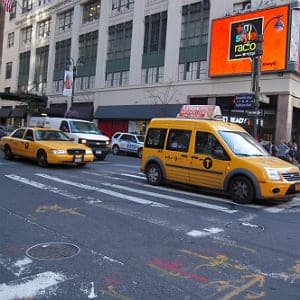In Norway, they call them pirattaxi, or "pirate taxis." In Malaysia, the term prebet sapu, or "sweep privates," is used. Residents of Baltimore call their unregulated drivers "hacks," a nod to the hackney coach rather than cybernetics. And in New York, we've chosen the title "gypsy cab."
These phrases suggest evocative images: lawless open seas, populated by eye patch-wearing marauders who employ hit-and-run guerrilla tactics. No rules, no regulation, just competition red in tooth and claw. As we'll see, that's not far from the truth.
New York City is home to a thriving unlicensed taxi industry, a disconnected fleet of unregulated cabs, serving residents ignored by the city's traditional, medallion-licensed cabs.
As an unregulated industry, there are no firm statistics on how many gypsy cabs are trolling New York City's streets. But one indication of the industry's size could come from enforcement. In 2012, the Taxi & Limousine Commission (TLC) confiscated a record 5,776 illegal livery vehicles, an increase of more than 230% from 2011.
 Here's what the TLC's strict regulations guarantee:
Here's what the TLC's strict regulations guarantee:
Gypsy cabs are just cars and drivers. There's no guarantee of insurance, vehicle maintenance, or driver reliability. There's no guarantee at all. And if a gypsy is insured, it might only be for the New York State minimum: $25,000 for bodily injury and $50,000 for death.
Much like the pirates of old, gypsy cabs are the simple result of economic reality in many large cities.
Taxi medallions, which mark a cab as regulated, licensed, and certified to accept fares by the TLC, cost as much as $1.25 million apiece as recently as November 2013. An intensely high sum for drivers who make a median annual income of $38,615.
And while only 13,437 taxi medallions are available, rider demand is much higher than the regulated fleet can meet on its own. By strictly limiting the number of yellow cabs, the TLC has constructed a high barrier to entry for potential drivers. In concert with New York City's unmet demand for taxi travel, the medallion system has effectively produced its own black market.
Certified drivers generally stay within the boundaries of Manhattan. According to the Taxi & Limousine Commission (TLC), 90.3% of all pick-ups occur in New York's Central Business District, and another 3.5% serve the airports. These areas, full of life and travel-ready residents, guarantee fares, and most drivers choose to remain within the most robust market. Cabbies also feel that better tips can be found in wealthier neighborhoods.
But the physical structure of New York also plays a role in the gypsy cab industry. As an island, travel in New York City is made possible by tunnels and bridges, which carry their own set of costly tolls, a disincentive to drivers and passengers alike. As a result, residents of the city's outer boroughs become used to a lack of taxis and find alternate modes of transportation. Cab drivers pick up on this decrease in demand, reinforcing their reliance on Manhattan's market.
When residents of the Bronx, Brooklyn, Queens, and Staten Island do take cabs, they're faced with an extra disincentive. Most unlicensed cabs don't have meters, and fares are agreed-upon in advance. Metered fares, on the other hand, may calculate rates in relation to the rate of travel, the time it takes, in addition to distance. Traveling longer distances, especially in congested traffic, can be a significant hit to one's pocketbook, one many passengers aren't willing to bear.
In recent years, the name "gypsy cab" has become attached to a type of legal taxi, too. "Livery cabs," generally black sedans, came into existence to serve neighborhoods with less foot traffic, and less customers, than Manhattan.
In order to find fares, livery cabs relied on radio dispatchers, rather than trolling for street hails. The TLC enshrined this distinction, and it's now illegal for a livery cab to pick you up on the street. But they do, and New York's licensed yellow cab drivers routinely complain about this unlawful competition.
Licensed cab drivers often fear perceived dangers in the outer boroughs: theft, kidnapping, or worse at the hands of unscrupulous riders. They may be right; driving a livery cab is extremely dangerous. According to Columbia University's News Service, more than two livery cab drivers are murdered every month by their passengers.